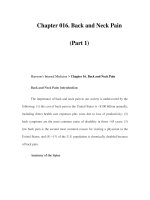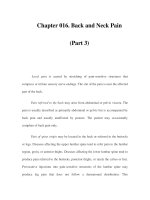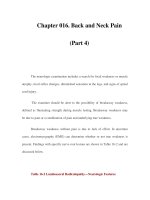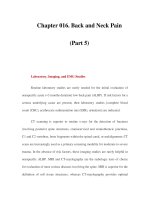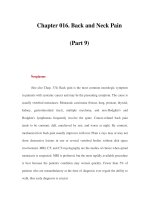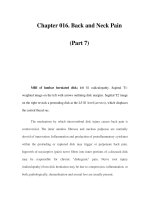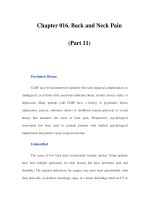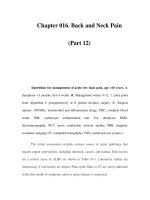Chapter 016. Back and Neck Pain (Part 3) ppsx
Bạn đang xem bản rút gọn của tài liệu. Xem và tải ngay bản đầy đủ của tài liệu tại đây (13.6 KB, 5 trang )
Chapter 016. Back and Neck Pain
(Part 3)
Local pain is caused by stretching of pain-sensitive structures that
compress or irritate sensory nerve endings. The site of the pain is near the affected
part of the back.
Pain referred to the back may arise from abdominal or pelvic viscera. The
pain is usually described as primarily abdominal or pelvic but is accompanied by
back pain and usually unaffected by posture. The patient may occasionally
complain of back pain only.
Pain of spine origin may be located in the back or referred to the buttocks
or legs. Diseases affecting the upper lumbar spine tend to refer pain to the lumbar
region, groin, or anterior thighs. Diseases affecting the lower lumbar spine tend to
produce pain referred to the buttocks, posterior thighs, or rarely the calves or feet.
Provocative injections into pain-sensitive structures of the lumbar spine may
produce leg pain that does not follow a dermatomal distribution. This
"sclerotomal" pain may explain some cases of back and leg pain without evidence
of nerve root compression.
Radicular back pain is typically sharp and radiates from the lumbar spine to
the leg within the territory of a nerve root (see "Lumbar Disk Disease," below).
Coughing, sneezing, or voluntary contraction of abdominal muscles (lifting heavy
objects or straining at stool) may elicit the radiating pain. The pain may increase in
postures that stretch the nerves and nerve roots. Sitting stretches the sciatic nerve
(L5 and S1 roots) because the nerve passes posterior to the hip. The femoral nerve
(L2, L3, and L4 roots) passes anterior to the hip and is not stretched by sitting. The
description of the pain alone often fails to distinguish between sclerotomal pain
and radiculopathy.
Pain associated with muscle spasm, although of obscure origin, is
commonly associated with many spine disorders. The spasms are accompanied by
abnormal posture, taut paraspinal muscles, and dull pain.
Knowledge of the circumstances associated with the onset of back pain is
important when weighing possible serious underlying causes for the pain. Some
patients involved in accidents or work-related injuries may exaggerate their pain
for the purpose of compensation or for psychological reasons.
Examination of the Back
A physical examination that includes the abdomen and rectum is advisable.
Back pain referred from visceral organs may be reproduced during palpation of the
abdomen [pancreatitis, abdominal aortic aneurysm (AAA)] or percussion over the
costovertebral angles (pyelonephritis).
The normal spine has cervical and lumbar lordosis, and a thoracic kyphosis.
Exaggeration of these normal alignments may result in hyperkyphosis of the
thoracic spine or hyperlordosis of the lumbar spine. Inspection may reveal a lateral
curvature of the spine (scoliosis) or an asymmetry in the paraspinal muscles,
suggesting muscle spasm. Back pain of bony spine origin is often reproduced by
palpation or percussion over the spinous process of the affected vertebrae.
Forward bending is often limited by paraspinal muscle spasm; the latter
may flatten the usual lumbar lordosis. Flexion of the hips is normal in patients
with lumbar spine disease, but flexion of the lumbar spine is limited and
sometimes painful. Lateral bending to the side opposite the injured spinal element
may stretch the damaged tissues, worsen pain, and limit motion. Hyperextension
of the spine (with the patient prone or standing) is limited when nerve root
compression, facet joint pathology, or other bony spine disease is present.
Pain from hip disease may mimic pain of lumbar spine disease. Hip pain
can be reproduced by internal and external rotation at the hip with the knee and
hip in flexion (Patrick sign) and by tapping the heel with the examiner's palm
while the leg is extended.
With the patient lying flat, passive flexion of the extended leg at the hip
stretches the L5 and S1 nerve roots and the sciatic nerve. Passive dorsiflexion of
the foot during the maneuver adds to the stretch. While flexion to at least 80° is
normally possible without causing pain, tight hamstring muscles are a source of
pain in some patients.
The straight leg–raising (SLR) test is positive if the maneuver reproduces
the patient's usual back or limb pain. Eliciting the SLR sign in the sitting position
may help determine if the finding is reproducible. The patient may describe pain in
the low back, buttocks, posterior thigh, or lower leg, but the key feature is
reproduction of the patient's usual pain. The crossed SLR sign is positive when
flexion of one leg reproduces the pain in the opposite leg or buttocks.
The crossed SLR sign is less sensitive but more specific for disk herniation
than the SLR sign. The nerve or nerve root lesion is always on the side of the pain.
The reverse SLR sign is elicited by standing the patient next to the examination
table and passively extending each leg with the knee fully extended. This
maneuver, which stretches the L2-L4 nerve roots and the femoral nerve, is
considered positive if the patient's usual back or limb pain is reproduced.
